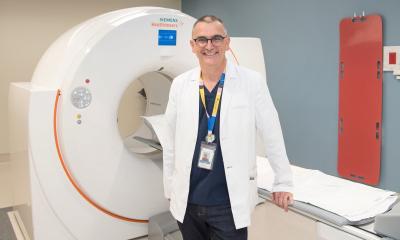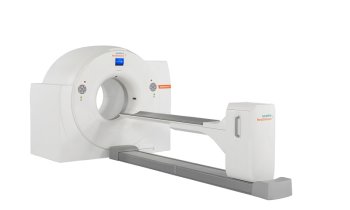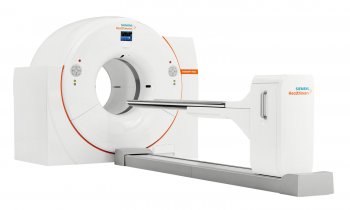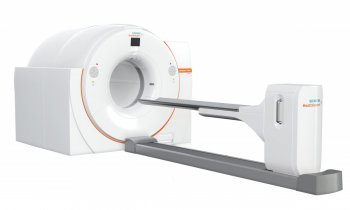PET scanning the heart cuts costs
USA - Using positron emission tomography (PET) scanning rather than other types of imaging as the first tool to diagnose heart-vessel blockages is more accurate, less invasive and saves money, according to researchers reporting at the American College of Cardiology's Annual Scientific Session in March.
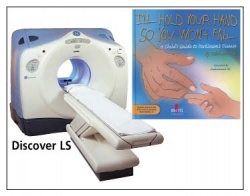
Results of the study provide a rationale for PET scanning to become the initial diagnostic test for assessing a patient’s risk of heart attack, said lead researcher Michael Merhige MD, clinical associate professor of nuclear medicine, and Joseph Oliverio, certified nuclear medicine technologist and clinical instructor of nuclear medicine - both at the University At Buffalo (www.buffalo.edu), and affiliated with the Heart Centre of Niagara at Niagara Falls Memorial Medical Centre.
Often PET scanning is the last test to be used, but Professor Merhige said, however, he added: ‘Because it is more accurate and provides a clearer picture of the state of the heart, it could decrease the use of angiograms (costing about $4,800 each) and bypass surgery by more than 50% if used as the first-line test with patients. Currently cardiologists conduct a range of tests, including stress tests and single photon emission computed topography, or SPECT.’ But he added that false readings from SPECT often put patients through angiograms that turn out to be normal. ‘PET avoids most false positives, as well as false negatives, because the images have higher resolution.’
There is not much peer-reviewed literature that compares PET to SPECT (the current standard), so coronary PET scanning is considered experimental in this field, although some 25 US centres are thought to use it for cardiac assessment, and one has done so for about a decade.
The researchers compared costs and results for SPECT scanning 102 patients, with PET scanning for 2,159 patients. All the patients were matched by the extent of coronary artery disease. Data was also compared from the 102 SPECT patients with data from a national multi-centre trial to confirm that the team’s results were valid. These showed that both the rate of heart attack and cardiac death were significantly lower after one year in patients managed by PET, as was the number of angiograms, balloon angioplasty with stenting and coronary bypass surgery. In the PET group, the average cost of management of a patient with coronary artery disease was also lower - by 25%.
Whilst Prof. Merhige said bypass surgery and angioplasty with stenting is a necessity for some patients, he believes many are done unnecessarily and medical management could be an alternative. Significant lifestyle changes - very low-fat diet, exercise, cholesterol-lowering drugs and stress management - are essential for successful medical management, he pointed out, but some people see surgery as a quicker option ‘...when it actually only addresses symptoms, not the underlying disease process,’ he said.
A child’s view of PD, written by Rasheda Ali, daughter of the great fighter, is set to help greater understanding. Report: Brenda Marsh
Mohammed Ali developed a shuffling walk and slurred speech, the onset of PD, in the mid-80s. But what Rasheda, one of his nine children, remembers is just accepting it as ‘old age’. Gradually, she accepted what it was. ‘Slurred speech certainly is an obstacle in my family,’ she said, smiling. In later years, when she had her own children, she avoided the laboured phone calls with Ali, preferring to visit him, to ‘... have that body language - facial expressions become more important than words,’ she pointed out, during her international tour in April to promote the guide. ‘The majority of people with PD are very sharp, very alert,’ she stressed. ‘The biggest misconception is that it’s the same as Alzheimer’s. My father has a perfectly clear mind. He just has shaking hands and slurred speech. So he chooses not to speak. The family has developed a whole series of nonverbal ways of communicating. I was sitting with my dad at an event when a woman asked if I thought my dad would give her an autograph. “Why don’t you ask him? He can understand every word you say,” I told her.’ He smiled and signed the autograph.
During a visit to Ali’s Michigan farm under a year ago, she watched her two sons, communicating with her father. Her younger son, Nico, had been playing with Ali, in his boxing ring, then asked her: Why is Popi shaking? ‘I was stumped,’ Rasheda recalls, ‘All I could think was “Well, he has Parkinson’s” but that means nothing to a four-year-old.’ Over a period of time, some of her children’s questions, included: Why doesn’t he answer me? and when told it was due to PD, asked How did he get it? Is it contagious? Would they get it, too. ‘I thought a lot of other parents out there probably didn’t have answers for their kids, either,’ she said, explaining the inspiration to write the guide.
In health, she said, ‘My father has good and bad days’, but he still travels to meet fans 280 days of the year. ‘My father really was the people’s champion, and he is still a fighter, but these days his opponent is Parkinson’s disease.’ One of his frequent stops is the Muhammad Ali Centre, in Louisville, Kentucky, and he is very involved with the Ali PD Data Base, into which doctors feed information about patients with the disease, to help researchers to find any common denominators that link their experiences.
Rasheda does not believe Ali’s PD was caused by boxing, though feels more research is needed to fully rule it out. ‘There are tens of thousands of ex-boxers out there, and I only know of two diagnosed with Parkinson’s,’ Rasheda pointed out. Exercise is considered vital for those with PD, and Ali uses his boxing ring, shadow-boxing and hitting punchbags.
Ali also draws and paints, she said, showing a picture done for her sons. It depicts a boxing ring with a multitude of dots for people - it is vibrant and meaningful. ‘His feeling and love for art and drawing, and my kids’ love for art and drawing, is drawing them together. They almost create their own universe when they are together,’ she added.
‘For over 20 years I have had Parkinson’s disease. Fortunately, my health has been reasonably good and I still do many of the things that I have always enjoyed. Even so, I am aware of how much this disease has diminished the quality of life I now enjoy,’ Ali writes, in a foreword of the book. ‘It becomes especially evident when I notice how my grandchildren and even my adult children become perplexed as the “new” me evolves. For my children the change has been gradual, but still the nuances of this disease are a challenge to us all. With my grandchildren it has been more difficult ... they find it difficult to communicate with me. They don’t understand why my arms tremor or my walking is stiff and rigid, or why I don’t smile as easily as they do.’
Book orders and contacts: www.meritpublishing.com
07.08.2006





